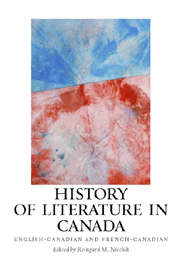Book contents
- Frontmatter
- Contents
- Acknowledgments
- Introduction: Writing a History of Literature in Canada
- I Beginnings
- II The Literature of New France, 1604–1760
- 3 Historical Background
- 4 Literature on New France
- 5 Colonial Literature in New France
- III The Literature of British Canada, 1763–1867
- IV From the Dominion to the Territorial Completion of the Nation, 1867–1918
- V The Modern Period, 1918–1967
- VI Literature from 1967 to the Present
- Further Reading
- Notes on the Contributors
- Index
4 - Literature on New France
from II - The Literature of New France, 1604–1760
Published online by Cambridge University Press: 12 September 2012
- Frontmatter
- Contents
- Acknowledgments
- Introduction: Writing a History of Literature in Canada
- I Beginnings
- II The Literature of New France, 1604–1760
- 3 Historical Background
- 4 Literature on New France
- 5 Colonial Literature in New France
- III The Literature of British Canada, 1763–1867
- IV From the Dominion to the Territorial Completion of the Nation, 1867–1918
- V The Modern Period, 1918–1967
- VI Literature from 1967 to the Present
- Further Reading
- Notes on the Contributors
- Index
Summary
THE WRITINGS ON NEW FRANCE constitute a great marginal literature spanning three centuries. The term “literature” has to be understood in a broader sense here, since literary texts, or works possessing an aesthetic value, were rare exceptions in this period. Such texts as did exist seldom concerned themselves with the French colony. Their subject was rather North America and the Native Americans — in other words, the anthropology, human geography, or, as it was called at the time, the natural history of the New World. After the discoveries, explorations, and voyages came the long and difficult missionary endeavors, conducted mostly by the Jesuits. As a result, the literature on New France, throughout the seventeenth century, drew a portrait of the Native American and of North America's tribes and confederations on a two-dimensional cultural graph, with the one axis running from friends and allies (including the Mi'kmaq, Montagnais, Algonquin, and Huron peoples) to enemies (the Iroquois Confederation, the Abenaki), that is, from savages to barbarians, and the other axis running from Christians to infidels. Native Americans were the main characters in these writings, not the explorers or missionaries — and still less the governors, administrators, and military leaders of the colony. For New France — unlike the Europeanization of the Dutch, British, Spanish, and Portuguese colonies — was indeed an attempt to make America and the Native Americans French, which also produced the opposite result, namely the Americanization of the French in America.
- Type
- Chapter
- Information
- History of Literature in CanadaEnglish-Canadian and French-Canadian, pp. 48 - 57Publisher: Boydell & BrewerPrint publication year: 2008

